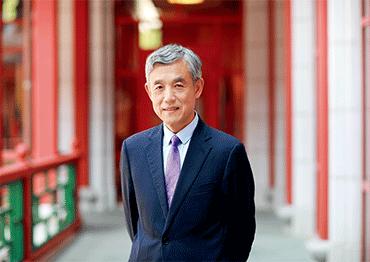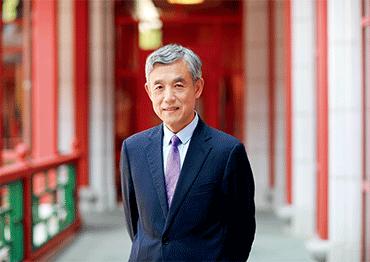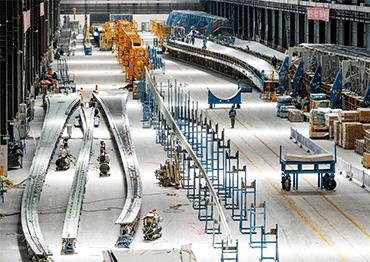n July 18, the 20th Central Committee of the Communist Party of China (CPC) concluded its third plenary session in Beijing, issuing a Communiqué that describes opening up as “a defining feature of Chinese modernization.” The resolution adopted at the session focuses on further deepening reform comprehensively to advance Chinese modernization and renewing the country’s plan for opening up.
The reform focuses on how to improve the national governance system and governance capacity to drive the construction of Chinese socialist modernization and the requirements of development in the new era, noted Xue Lan, a senior professor and chairman of the Academic Committee of the School of Public Policy and Management at Beijing-based Tsinghua University, in an interview with NewsChina right after the conclusion of the session.
NC: The Communiqué sets the goal of building a high-standard socialist market economy in all respects by 2035. What is the high-standard socialist market economy?
Xue Lan: In the socialist market economy, how to better leverage the roles of the market and the government is a key focus of attention. I believe that the fundamental direction of the reform has not changed. The socialist market economy remains the cornerstone, while it is essential to give full play to the decisive role of the market in resource distribution.
The Communiqué states that China will unswervingly consolidate and develop the public sector and unswervingly encourage, support and guide the development of the non-public sector. It will ensure that economic entities under all forms of ownership have equal access to production factors in accordance with the law, compete in the market on an equal footing, and are equally protected by the law, thus enabling entities of different ownership to complement each other and develop side by side.
Two points are clear here. First, there are still differences in the current development of the public sector and the non-public sector. The public sector has developed a solid foundation and great potential, and is expected to be stronger and better through reform. Meanwhile, the development environment for the non-public sector still needs to be improved with more encouragement, support and guidance. Second, the nondiscrimination principle is emphasized, stating that sectors in all types of ownership should have fair participation in market competition and receive equal legal protection.
According to conventional economic theory, a well-functioning market with fair competition does not necessarily guarantee the efficient allocation of resources and optimal operations of the market. In reality, various types of market failures can occur, such as the insufficient and ineffective provision of public goods, negative externalities like environmental pollution that cause societal losses, information asymmetry and natural monopolies. All hinder the efficient distribution of resources in the market, so the government has to address these market failures through public policies.
China is transitioning from a planned economy to a socialist market economy. On one hand, some market entities are still underdeveloped and need encouragement to explore and innovate. On the other, the government is gradually establishing a regulatory system to address market failures and ensure the healthy development of enterprises. This is what the Communiqué means by “lifting restrictions on the market” while “ensuring effective regulation.” The goal is to better maintain order in the market and remedy market failures. By doing so, China aims to ensure smooth flows of market resources in the national economy and unleash the internal driving forces and creativity of the whole of society.
In recent years, the concept of an active government has been a topic of considerable debate. However, there has been a lack of clarity regarding which specific areas warrant government intervention. This session provides a clear explanation of this. It stated that sound macro policy and regulation, along with effective governance, is essential for China to fully leverage the institutional advantages of its socialist market economy. Consequently, it is imperative for China to improve its macro regulatory systems. This entails pursuing coordinated reforms across fiscal, taxation, financial and other major sectors, while striving to enhance the consistency of macro policy orientation.
A critical challenge is the lack of sufficient coordination at the macro level when the government regulates the market. This deficiency can result in potentially conflicting policies from various departments.
For example, while encouraging full opening-up, there are multiple restrictions on the normal operations of foreign enterprises. To address this situation, this session emphasized the need for more systematic and holistic planning at the national macro-strategy level to ensure policy consistency and effectively implement coordinated policies.
It is important to distinguish between market mechanisms and market systems. The market system is a complex system where the government can play its role. The session has put forward some specific requirements for its role,such as coordinating reforms in key areas such as finance and taxation, which are practical challenges faced by the country in promoting high-quality development. In the future, efforts should focus on addressing governance deficiencies rather than resource allocation.
Regarding a high-standard socialist market economy, in the past, the idea of a socialist market economy was to introduce competitive mechanisms and diverse market entities and make the best use of market mechanisms. That was the focus of the first 30 years of reform and opening-up in China. However, in the past decade, China has realized that achieving high-quality economic development requires more than just competitive mechanisms and diverse market entities. It also necessitates a series of supporting institutions, such as a transparent and fair legal system and effective regulations.
There are more implications for the concept of a high-standard socialist market economy. As the Communiqué said, after building a high-standard socialist market economy, the emphasis will be placed on improving the mechanism and institutions for promoting high-quality economic development, which is a broader concept that involves various aspects.
NC: What do you think of the equal exchanges and two-way flows of production factors between the cities and the countryside for integrated development of urban and rural areas that is stated in the Communiqué?
XL: Achieving common prosperity is the path to and part of high-quality development. The uneven development between urban and rural areas has always been a major issue that needs to be addressed. This plenary session also identifies it as a key focus for reform. Over the past decade, China has achieved poverty alleviation, but this is just a foundation for common prosperity. Moving forward, China needs to unleash the vitality of rural areas, which requires strengthening institutional and systemic reforms in the process of new urbanization.
The Communiqué proposes to promote equal exchanges and two-way flows of production factors between the cities and the countryside, which indicates the direction of reform in the next stage. For example, some cities are piloting allowing migrant workers to register their residence and live there permanently. This experiment may accelerate in the future. The Communiqué also mentions the need to consolidate and improve the basic rural operation system. In rural areas, the most basic operating asset is land, which leaves room for future reforms.
Furthermore, the Communiqué mentions integrated urban and rural development, a concept first proposed in the report at the 19th National Congress of the CPC (2017) and further emphasized in the report at the 20th National Congress of the CPC (2022) which specifies areas such as factor mobility, public services and social security.
In the past, our approach was urban-rural integration. What is the difference between the two? Urban-rural integration emphasizes the development of cities and rural areas within a unified system, achieving orderly flow of resources and personnel. This involves some coordinated optimization in regional spatial layout, such as the integration of cities and suburbs. However, overall, cities remain cities and rural areas remain rural. Now, the concept of integrated urban and rural development implies that there are rural elements in cities, meaning that cities not only integrate with suburbs but also radiate out to remote towns and villages. This represents a higher level of coordinated urban-rural development, providing more opportunities for rural development.
NC: The Communiqué points out that opening up is a defining feature of China’s modernization. Has this plenary session provided new solutions to the challenges posed by complex international situation to China’s international cooperation?
XL: First, the Communiqué states that China must adhere to the basic State policy of opening up, which clearly demonstrates that China will continue to uphold openness and not close its doors. Second, given the current complex international environment, how should China navigate its openness?
During the first 30 years of reform and opening-up, China mainly focused on opening up to the US, Europe and Japan. Over the past decade, China has significantly expanded international cooperation, reaching out to regions such as Central Asia, Southeast Asia and Arab countries. This expansion has been particularly evident with partners along the Belt and Road Initiative (BRI), as China strives for more comprehensive openness.
To some extent, this shift has been influenced by the changing international environment. China will continue to expand international cooperation, refine regional opening-up strategies, and improve mechanisms to promote the high-quality development of the BRI.
Foreign investment remains a key focus in China’s opening-up policy. People anticipate robust policies from the government to attract more foreign capital into China. However, this challenge extends beyond mere macroeconomic policy adjustments. Even with favorable policies in place, some foreign enterprises may continue to experience a sense of discrimination and insecurity in their day-to-day practice. This issue stems from policy implementation, with the core problem being a lack of institutionalized guarantees for openness.
China’s journey toward openness has been a gradual process. In the early stages, this opening-up was primarily driven by special preferential policies for foreign enterprises, reflecting a policy-driven approach rather than an institutional one. At present, there is a pressing need for institutionalized openness. Therefore the Communiqué specifically emphasizes further reforms of the management systems for both inward and outward investment, representing a move toward institutionalized opening up. In the future, the true test will be whether China can genuinely treat foreign capital fairly in practice.
NC: The Communiqué also proposes to lead reform and development of the global governance system and shape a favorable external environment. What can China do?
XL: This is a very positive and important statement. Since the US adopted a “decoupling” policy, China has been trying to show gestures of goodwill to the rest of the world and cope with the situation. However, this gives the outside world an impression that China seems to be passively responding to the situation. The plenary session clearly states that in the future, China will also actively shape a favorable external environment, while continuing our own efforts to cope with the challenges.
In fact, China has already taken some actions in this regard. For example, on July 1, the United Nations General Assembly adopted a resolution proposed by China to strengthen international cooperation in building AI capabilities, which focuses on how developing countries can enhance their AI capabilities. China’s proposal has gained support from many developing countries who had long been eager to participate in AI governance but lacked the necessary capacity of doing so. This shows how China is playing a leading role in making global AI governance more diverse and inclusive.

 Old Version
Old Version

